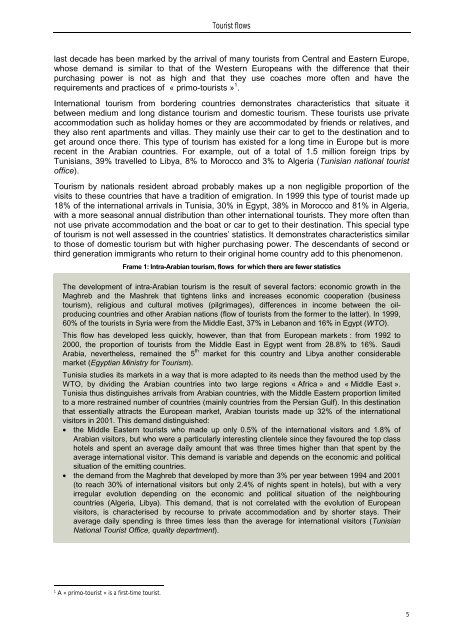dossier sur le tourisme et le développement durable
dossier sur le tourisme et le développement durable
dossier sur le tourisme et le développement durable
Create successful ePaper yourself
Turn your PDF publications into a flip-book with our unique Google optimized e-Paper software.
Tourist flows<br />
last decade has been marked by the arrival of many tourists from Central and Eastern Europe,<br />
whose demand is similar to that of the Western Europeans with the difference that their<br />
purchasing power is not as high and that they use coaches more often and have the<br />
requirements and practices of « primo-tourists » 1 .<br />
International tourism from bordering countries demonstrates characteristics that situate it<br />
b<strong>et</strong>ween medium and long distance tourism and domestic tourism. These tourists use private<br />
accommodation such as holiday homes or they are accommodated by friends or relatives, and<br />
they also rent apartments and villas. They mainly use their car to g<strong>et</strong> to the destination and to<br />
g<strong>et</strong> around once there. This type of tourism has existed for a long time in Europe but is more<br />
recent in the Arabian countries. For examp<strong>le</strong>, out of a total of 1.5 million foreign trips by<br />
Tunisians, 39% travel<strong>le</strong>d to Libya, 8% to Morocco and 3% to Algeria (Tunisian national tourist<br />
office).<br />
Tourism by nationals resident abroad probably makes up a non negligib<strong>le</strong> proportion of the<br />
visits to these countries that have a tradition of emigration. In 1999 this type of tourist made up<br />
18% of the international arrivals in Tunisia, 30% in Egypt, 38% in Morocco and 81% in Algeria,<br />
with a more seasonal annual distribution than other international tourists. They more often than<br />
not use private accommodation and the boat or car to g<strong>et</strong> to their destination. This special type<br />
of tourism is not well assessed in the countries’ statistics. It demonstrates characteristics similar<br />
to those of domestic tourism but with higher purchasing power. The descendants of second or<br />
third generation immigrants who r<strong>et</strong>urn to their original home country add to this phenomenon.<br />
Frame 1: Intra-Arabian tourism, flows for which there are fewer statistics<br />
The development of intra-Arabian tourism is the result of several factors: economic growth in the<br />
Maghreb and the Mashrek that tightens links and increases economic cooperation (business<br />
tourism), religious and cultural motives (pilgrimages), differences in income b<strong>et</strong>ween the oilproducing<br />
countries and other Arabian nations (flow of tourists from the former to the latter). In 1999,<br />
60% of the tourists in Syria were from the Midd<strong>le</strong> East, 37% in Lebanon and 16% in Egypt (WTO).<br />
This flow has developed <strong>le</strong>ss quickly, however, than that from European mark<strong>et</strong>s : from 1992 to<br />
2000, the proportion of tourists from the Midd<strong>le</strong> East in Egypt went from 28.8% to 16%. Saudi<br />
Arabia, neverthe<strong>le</strong>ss, remained the 5 th mark<strong>et</strong> for this country and Libya another considerab<strong>le</strong><br />
mark<strong>et</strong> (Egyptian Ministry for Tourism).<br />
Tunisia studies its mark<strong>et</strong>s in a way that is more adapted to its needs than the m<strong>et</strong>hod used by the<br />
WTO, by dividing the Arabian countries into two large regions « Africa » and « Midd<strong>le</strong> East ».<br />
Tunisia thus distinguishes arrivals from Arabian countries, with the Midd<strong>le</strong> Eastern proportion limited<br />
to a more restrained number of countries (mainly countries from the Persian Gulf). In this destination<br />
that essentially attracts the European mark<strong>et</strong>, Arabian tourists made up 32% of the international<br />
visitors in 2001. This demand distinguished:<br />
• the Midd<strong>le</strong> Eastern tourists who made up only 0.5% of the international visitors and 1.8% of<br />
Arabian visitors, but who were a particularly interesting cliente<strong>le</strong> since they favoured the top class<br />
hotels and spent an average daily amount that was three times higher than that spent by the<br />
average international visitor. This demand is variab<strong>le</strong> and depends on the economic and political<br />
situation of the emitting countries.<br />
• the demand from the Maghreb that developed by more than 3% per year b<strong>et</strong>ween 1994 and 2001<br />
(to reach 30% of international visitors but only 2.4% of nights spent in hotels), but with a very<br />
irregular evolution depending on the economic and political situation of the neighbouring<br />
countries (Algeria, Libya). This demand, that is not correlated with the evolution of European<br />
visitors, is characterised by recourse to private accommodation and by shorter stays. Their<br />
average daily spending is three times <strong>le</strong>ss than the average for international visitors (Tunisian<br />
National Tourist Office, quality department).<br />
1 A « primo-tourist » is a first-time tourist.<br />
5
















